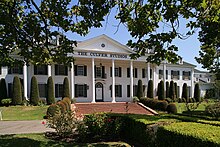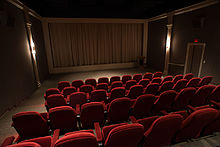This is an old revision of this page, as edited by KConWiki (talk | contribs) at 03:47, 5 August 2014 (→Select films). The present address (URL) is a permanent link to this revision, which may differ significantly from the current revision.
Revision as of 03:47, 5 August 2014 by KConWiki (talk | contribs) (→Select films)(diff) ← Previous revision | Latest revision (diff) | Newer revision → (diff)34°01′26″N 118°23′33″W / 34.023894°N 118.392475°W / 34.023894; -118.392475

The Culver Studios is an historic movie studio located at 9336 West Washington Boulevard in Culver City, California. Originally created by silent movie pioneer Thomas H. Ince, many classics from Hollywood’s Golden Age were filmed including Gone with the Wind.
The Culver Studios was also used for television shows such as The Andy Griffith Show, Lassie, Batman and, more recently, Scrubs, Arrested Development and Cougar Town.
The lot has had multiple owners over the decades from wealthy individuals to business conglomerates. Eccentric businessman Howard Hughes once had a stake in the studio as well as filmmakers Cecil B. DeMille and David O. Selznick.
It is currently owned by Hackman Capital Partners.
History
Ownership
The Culver Studios was built by Thomas H. Ince in 1918 after he acquired it from landowner Harry Culver. The silent movie actor, director and producer had grand ambitions to create his own studio unique from all the others. The first building to go up on the lot was “The Mansion” - a picturesque Colonial-styled administrative building with a white facade and grand columns overlooking manicured lawns. It was modeled after George Washington’s home on Mount Vernon.
The original studio was named the Thomas H. Ince studios and became the second major motion picture concern in Culver City. Ince operated it until his early death in 1924 and the following year his widow sold the property to Cecil B. DeMille who renamed it DeMille Studios. DeMille ran the lot for two years during which time the site underwent several large-scale expansions and renovations, including the construction of the DeMille theater and a replica of the streets of Jerusalem for his film The King of Kings (1927).
Despite a couple of major box office hits, DeMille failed to make the studio financially sustainable and merged his company with Pathé Exchange Inc. in 1928. DeMille signed a three-picture deal with Metro-Goldwyn-Mayer and the lot remained under the ownership of a conglomerate of companies. Another merger took place In 1928, when RKO (Radio-Keith-Orpheum) Pictures bought the site. To distinguish it from their Hollywood property, they operated under the name to become RKO-Pathé studios even though Pathé was no longer an active partner. Further improvements took place and stars Bette Davis, Robert Mitchum, Cary Grant, and Katharine Hepburn all saw their careers continue to blossom while filming on the lot. Sets were also used in the original version of King Kong (1933)
RKO rented out the lot for virtually the entirety of its ownership and seldom used the space to shoot their own productions. From 1935 to 1946, the site was leased to Selznick International Studios, owned by David O. Selznick, and it underwent more renovations. Selznick is best remembered for being the producer of Gone With the Wind and entire abandoned sets on the backlot were set ablaze to recreate the burning of Atlanta scenes.
After 1946, RKO-Pathé resumed operation of the site and leased the space to David O. Selznick’s new Vanguard Films Inc. as well as a variety of other independent production companies. Tycoon and movie producer Howard Hughes bought the studio in 1950 and continued to lease out the space to production companies until he sold RKO Pictures to General Tire.
Desilu Productions, owned by Lucille Ball and Desi Arnaz, purchased the lot from General Tire in 1956 and television soon became the primary business conducted on site. The site continued to change owners until it was acquired by Sony Pictures in 1991. During their period of ownership, it was renamed The Culver Studios.
The Culver Studios was bought by a private investment group Studio City Los Angeles in April 2004 for $125 million. It included Lehman Brothers, Pacific Coast Capital and Pacifica Ventures.
In honor of its original owner, Thomas H. Ince, the street running through the middle of the studio has been named Ince Boulevard.
In March 2014, the Culver Studios was purchased by another private investment group, Hackman Capital Partners (HCP). When rumors persisted that the lot would be replaced by condominiums, HCP CEO Michael Hackman debunked those claims. However, Hackman said that the studio will be renovated to take advantage of modern technology, as well as adding extra parking and production space.
Site development
Throughout its history, Culver Studios continued to undergo numerous expansions and adaptations to meet the changing needs of the movie industry. The major works took place between 1918 and 1946, during the tenures of Thomas H. Ince, Cecil B. DeMille, RKO and David O. Selznick.
Ince built the original studio, now known as The Culver Studios, on a 14-acre site. When the lot was bought by DeMille in 1925, large scale site renovations began. He reoriented the existing stages and moved numerous office bungalows and production servicebuildings. To match production needs, Stage 2 (now known as Stages 2/3/4), four new double-barrelled projection rooms and seven new cutting rooms were added to the studio site.
In 1930, under the ownership of Pathe Exchange Inc., the area was again renovated and redesigned. The arrival of talking pictures brought a massive new growth to Hollywood and an increased demand for movies. RKO-Pathe Studios built two large stage facilities (stages 7/8/9 and 11/12/14) and several production service buildings.
It was not until David O. Selznick's time at the helm, from 1935 to 1946, that the studios became fully built out and included new on-site bungalows. A final stage facility was built (stages 15/16) and the main studio site was developed to closely resemble the current layout.
Back Forty
As the Culver Studios grew in size and stature, a 28.5 acre backlot was used to build full-scale outdoor sets. The Back Forty, also known as Forty Acres, sat on a triangular plot of land a few blocks from the main lot.
It was initially leased from landowner Harry Culver during Cecil B. DeMille's tenure and was continuously used to build the plantation Tara, the Atlanta Depot and other Atlanta buildings in the 1939 film Gone With the Wind.
The Back Forty also provided the backdrop for several classic television shows including The Andy Griffith Show, The Adventures of Superman, Star Trek and Bonanza.
The land is no longer connected to the Culver Studios and currently serves as an office park.
Modern day
Facilities

The Culver Studios has 13 stages, on-site offices, a screening theater, fitness facility, medical services and parking.
Mansion House
The picturesque mansion house is the centerpiece of Culver Studios lot and has landmark status. It is a classic example of 1920s Colonial Revival architecture and was the first building to go up on the site shortly after Thomas H. Ince's acquisition of the land in 1918. Modeled after George Washington's home on Mount Vernon, it currently serves as the main administrative building on the lot. Famous directors including Ince, Cecil B. DeMille and David O. Selznick once had offices there.
One long corridor runs the length of the 15,000 square foot structure which has eight two-story high grand white columns. The facade looks out onto a manicured lawn.
There is a common misconception that the mansion house was Tara in Gone With the Wind. The building was used in the credits but Tara was constructed by art director Lyle Wheeler. The scene in the movie from the burning of Atlanta was filmed on the lot however. After filming concluded, the facade of Tara sat on the backlot of Culver Studios, which was known as Forty Acres.
Bungalows
At the southern end of Culver Studios sit a collection of four bungalows, dating back to the 1920s and 1930s. They have been occupied by a host of celebrated writers and actors over the years and are now considered locally significant structures.
Alfred Hitchcock used one of the one-story buildings as his office for years. Another bungalow was built in 1935 and used as a residential space for Clark Gable and Vivien Leigh during filming of Gone With the Wind. Other bungalows have been connected to Olivia de Havilland, Lucille Ball, Gloria Swanson and Orson Welles during the filming of Citizen Kane.
Today they are used as production spaces and offices for writers, producers, production staff and talent.
Cecil B. DeMille Theater

Built by producer Cecil B. DeMille in 1927 when he owned the studio, the theater is adjacent to the mansion house. It was dedicated to DeMille in 1984 and available for special screenings, fundraisers and production daily viewings.
It has 70 seats, a 24 ft x 11 ft screen, digital and 35mm projectors.
Productions
Culver Studios has helped spawn the career of numerous movie and television stars. In the lot's earlier days, the site was used to film Hollywood classics like Citizen Kane and Hitchcock's Spellbound before a plethora of television shows started leasing the stages in the 1960s to create programs like The Andy Griffith Show and Hogan's Heroes.
In more recent decades, the site has again become the setting for movies including The Matrix, Armageddon and I Am Legend while providing a home to popular television shows such as Arrested Development and Cougar Town.
Select films
- 1933: King Kong (scene on Skull Island)
- 1937: A Star Is Born
- 1939: Gone With the Wind (the burning of Atlanta)
- 1940: Rebecca
- 1944: Since You Went Away
- 1945: Spellbound
- 1946: Duel in the Sun
- 1976: Carrie
- 1976: Rocky
- 1978: Sergeant Pepper’s Lonely Hearts Club Band
- 1979: The Jerk
- 1980: Raging Bull
- 1980: Airplane
- 1981: E.T.
- 1984: Prizzi’s Honor
- 1986: Three Amigos
- 1987: RoboCop
- 1987: Planes, Trains and Automobiles
1988: Beetlejuice
1991: Bugsy
1991: Hook
1992: A Few Good Men
1995: Nixon
1996: Air Force One
1997: Red Corner
1997: Contact
1998: Armageddon
1999: The Matrix
1999: Wag the Dog
2000: What Women Want
2001: Legally Blonde
2002: Kill Bill
2003: 50 First Dates
2003: Peter Pan
2004: Bewitched
2006: Night At The Museum
2007: I Am Legend
2007: State of Play
2008: Valkyrie
2008: Tim Burton’s Alice in Wonderland
2011: X-Men First Class
2012: The Campaign
2012: Argo (reshoots)
Select TV
1959: The Untouchables
1960: The Andy Griffith Show
1965: Hogan’s Heroes
1965: I Spy
1966: Batman
1967: Star Trek (pilot)
1986: Pee-Wee’s Playhouse
1987: Beauty and the Beast
1989: Baywatch
1992: Mad About You
1993: The Nanny
2004: King Of Queens
2004: Arrested Development
2005: Las Vegas
2006: Deal or No Deal
2008: America’s Next Top Model
2009: Scrubs
2009: Cougar Town
2009: Giada at Home
2011: Ringer
2012: Ricki Lake Show
2012: Arrested Development
2013: Comedy Central’s James Franco Roast
2013: Giada At Home
2013: Kris Jenner
2013: Episodes
References
- The Culver Studios: official website
- Official page for the City of Culver City: CulverCity.org
- Cecil B. DeMille biography
- Seeing Stars
- Ghost stories: Culver City News
- Ghost stories: Prairie Ghosts website
- Ghost stories: Yahoo
- YouTube link to original Thomas H. Ince studios